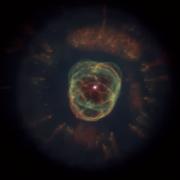In the second part of our tour through the winter sky we shall look at some more deep sky celestial treats to tempt you outside.
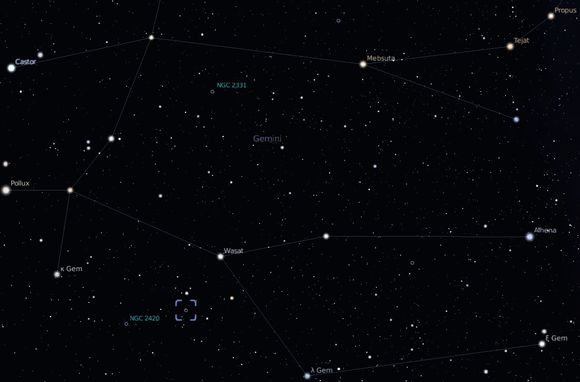
NGC 2392 ("Clown Face" or "Eskimo" Nebula") is 2 degrees up and right of the NGC 2420 Open Cluster, shown on the chart above.
To begin, locate the constellation of Gemini, the twins, whose two leading stars, Castor and Pollux ride quite high in the South-East sky. The object we are seeking is the Planetary Nebula - NGC 2392 or ‘The Clown face’ nebula, a telescopic object well worth observing. To find -follow the line of stars in Gemini extending away from Pollux.
The second star along, called Wasat, is our “jumping off” point. Place Wasat at the left side of the finder scope field and aim in the direction of a trio of stars (63 Geminorum). A tad further in this direction brings two stars into view; one of these looks out of focus and is the nebula. Under high magnification the greenish colour is quite distinct, but to see the patches that give this nebula its name is beyond the range of most backyard scopes. The nebula is approx 3,000 lightyears distant and is young just 2,000 years old.
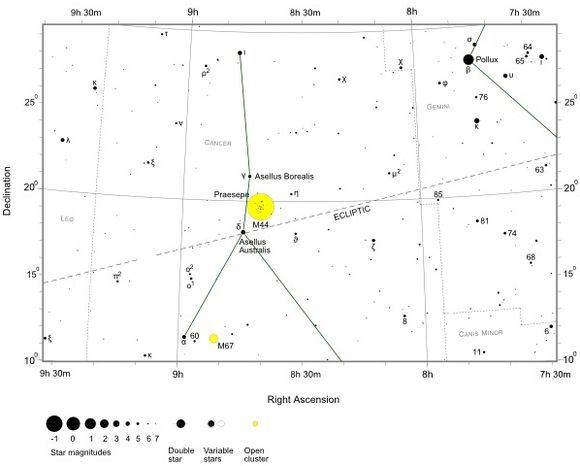
Messier Finder Chart for M44 - Praesepe: "Beehive Cluster" and M67 "King Cobra Cluster)
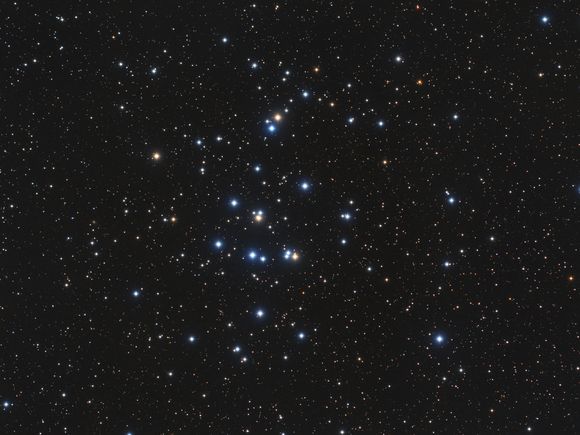
M44 - Praesepe: "Beehive Cluster" in the Constellation of Cancer ("the Crab")
Our next object lies in Cancer, the Crab whose faint stars are found to the lower left of Castor and Pollux. On nights of good seeing and away from light pollution this object should be visible to the naked eye as a milky patch of light, it is M44 “the Beehive” or Praesepe open cluster. If you need directions it is located midway and a little to the right of two faint stars called the Asses. Even in binoculars or a finder scope some of the stars in this lumpy soup of light will be resolved. Through a scope this object is magnificent with over 70 stars being visible in a “milky haze” including many doublets and triplets some of which are orange -red in colour. In all the cluster contains over 400 members and lies 500 lightyears away, it is reckoned to be over 400 million years old.
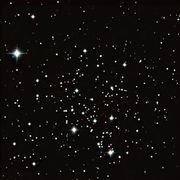
M67 "King Cobra": thought to
be oldest Messier open cluster.
To find our next object, project down from the two stars called the Asses a distance equivalent to twice their separation to a spot just to the right of a dim 4th magnitude star in Cancer called Acubens. In binoculars or finder scope a small ball of light will be visible; this is the open cluster M67. This grainy ball is seen best under high magnification when many fainter stars can be resolved. M67 is unusual in that it is situated 1,500 Lyears above the galactic plane some 2500 lightyears away where the gravitational pull of other stars is much weaker, hence this open cluster has remained together. A good number of its 400 plus members have evolved into their Red giant stage, making M67 the oldest open cluster known - 7 to 10 billion years!
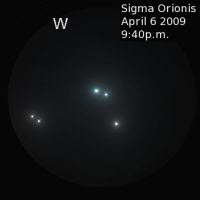 Next on the menu are a couple of triple star groupings, the first is Sigma Orionis which can be found directly below Alnitak - the bottom star of Orion’s belt. When viewed through a small scope (2-4 inch) 3 stars are visible arranged in a pleasing group, this becomes a quartet when larger scopes are used. Incidentally, we have all seen images of the Horsehead nebula – but to actually observe it, is quite tricky. A 10” scope or more, a light pollution filter, a really dark sky and patience, are required, or you can take long exposure images of the region around Alnitak, the nebula should stand out then, but it is rather small.
Next on the menu are a couple of triple star groupings, the first is Sigma Orionis which can be found directly below Alnitak - the bottom star of Orion’s belt. When viewed through a small scope (2-4 inch) 3 stars are visible arranged in a pleasing group, this becomes a quartet when larger scopes are used. Incidentally, we have all seen images of the Horsehead nebula – but to actually observe it, is quite tricky. A 10” scope or more, a light pollution filter, a really dark sky and patience, are required, or you can take long exposure images of the region around Alnitak, the nebula should stand out then, but it is rather small.
Moving on, look to the barren region to the left of the belt stars, this is the home of Monocerus the Unicorn. The star we’re after is Beta Monocerotis the left star of the two visible here. Once located this is a nice triplet made up of a white primary and two fainter blue companion stars arranged in a crooked line. Again in larger scopes this group becomes a quadruple system. It lies at a distance of 450 lighyears.
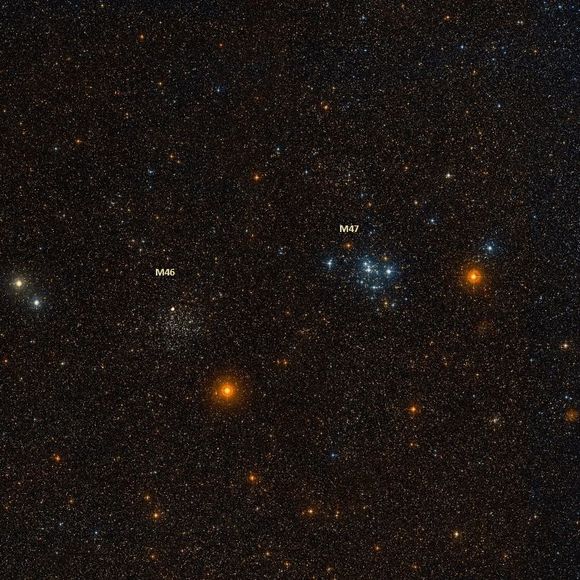
M46 and M47: Open Clussters in constellation Puppis
Our final objects all lie in Puppis - found to the left of Canis Major home to the brightest star - Sirius. The two open clusters of M46 and M47 reside two/ three binocular fields to the left of Sirius, and are visible as two adjacent misty patches. In small scopes M46 does not look as impressive as its neighbour M47 - a speckled hazy cloud, however larger scopes resolve M46 into hundreds of faint stars 5600 lightyears away. M47 is just 1500 lightyears distant.
From these two clusters travel almost due south and level with Wezen, the top star of a trio of bright stars some way below Sirius. Searching this area you will come across a faint concentrated nebulous patch of light - this is M93 an impressive cluster when viewed at high powers with over 3 dozen stars resolved. The cluster lies 3500 lightyears away and is roughly 100 million years old.
- Log in to post comments

